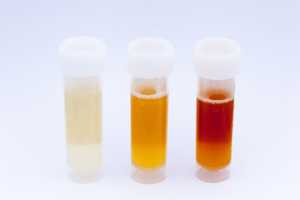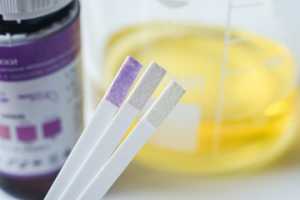Significance of Urine Routine Test in the Diagnosis of UTI and Kidney Diseases
What is a urine routine test?
A urine routine test is a set of tests that involves physical, chemical, and microscopic analysis of urine.
A wide range of disorders affects the way the body eliminates toxins and waste. Your urinary tract, skin, lungs, bladder, and kidney are some of the organs involved in removing waste and toxins. A problem with any of this organ may change your urine’s appearance, specific gravity, and content.
The physical analysis records its:
- Quantity
- Appearance
- Colour
- Specific gravity
- pH
- Deposit
Chemical analysis detects the presence of
- Blood
- Sugar
- Urobilinogen
- Proteins
- Ketone
- Bile salts
- Bile pigment

Microscopic analysis checks the presence of
- Red blood cells
- Epithelial cells
- Pus cells
- Microbes
- Crystals
Abnormal urine routine test results may indicate a disease or an illness. For instance, if the urine appears cloudy, it can be a sign of urinary tract infection. A large amount of protein in urine can be a sign of kidney disease.
Why is a Urine Routine Test Performed?
A urine routine test is done:
- To diagnose kidney diseases and urinary tract infections
- To diagnose conditions that cause an abnormal breakdown of products which are eliminated from the body through urine
What are the Reasons to Take This Test?
- Symptoms of kidney failure, urinary tract infection
- Dysuria(burning sensation during urination)
- Bloody or cloudy urination
- Frequent urination
- Edema(swelling of body parts as a result of injury)
- Fever
- Chills(shivering)
- High blood pressure
- Back pain
- Vomiting
- Metallic taste in the mouth
- Sleepiness
- Fatigue
- Loss of appetite
- Twitching
- Itching
How is the Urine Routine Test Performed?

No special preparations are required before a urine routine test. A urine sample is required for this test. It’s essential that before the collection, you should cleanse your genitals. Midstream urine is normally collected for this test. Start urinating into the toilet, and the first few drops should not be collected. Pass the sterile container into your urine stream and collect the midstream urine. The last few drops should not be collected. Place the lid atop the container and refrigerate the sample.
Urine Routine Test Normal Values
| Reference range | Interpretation |
| Colour | Colourless, pale/dark yellow or amber |
| Specific gravity | 1.005 to 1.025 |
| pH | 4.5 to 8 |
| Blood | ≤3 RBCs |
| Glucose | ≤130 mg/d(milligrams per day) |
| Urobilinogen | 0.1 to 1.0 |
| Protein | ≤150 mg/d |
| Ketone | None |
| Red blood cells | ≤2 RBCs/hpf(red blood cells per high power field) |
| Squamous epithelial cells | ≤15-20 squamous epithelial cells/hpf |
| Pus cells | 2 to 3 pus cells/hpf |
| Crystals | Acid urine |
| Casts | 0-5 hyaline casts/lpf (hyaline casts per low power field) |
| Turbidity | Clear to slightly hazy |
| White blood cells | ≤2-5 WBCs/hpf |
What Do the Results Indicate?
In a urine routine test, your urine sample is analyzed in 3 different ways.
Visual Exam
During a visual exam, the lab technician checks the appearance of urine. Typically urine is clear. Cloudy urine or urine with abnormal odour can be a sign of an infection. The urine sample may appear reddish or brown because of the presence of blood. Having some foods, such as rhubarb or beetroot, may turn urine red.
Dipstick Test

During a dipstick test, the lab technician dips a small stick containing chemical strips into the urine sample. If the colour of the strip changes, it means certain substances in abnormal levels in your urine. The test measures:
Sugar(glucose): Typically, the glucose level in urine is too low to be detected. A follow-up test for diabetes should be done if the sugar is detected in your urine.
Ketones: Similar to that of sugar levels, if ketones are detected in your urine sample, then it may indicate diabetes, and your doctor may order a follow-up test.
Acidity(pH): A higher than normal pH level can sign a urinary tract disorder or a kidney disorder.
Protein: Typically, low amounts of protein in urine is considered normal. High levels of protein in urine can be a sign of kidney problems.
Specific gravity or concentration: Abnormal specific gravity can occur as a result of not drinking enough fluids.
Blood: Your doctor may order additional tests if there is blood in your urine. It may indicate
- Kidney or bladder cancer
- Blood disorders
- Bladder or kidney stones
- Kidney damage
- Infection in Kidney
Bilirubin: It is a yellowish pigment made by the liver. Bilirubin in your urine sample can be a sign of liver disease or damage.
Microscopic Exam

During a microscopic exam, drops of urine are added on a glass slide and viewed under a microscope. You may require additional tests if your urine sample has any of the following substances at above-average levels.
- Red blood cells(RBC): Erythrocytes or Red blood cells in urine may indicate-
- Bladder cancer
- Kidney disease
- Blood disorder
- White Blood cells(WBC): Leukocytes or white blood cells in urine may indicate an infection.
- Crystals: Crystals in urine may show a kidney stone.
- Microbes: Bacteria or yeasts in urine can be a sign of an infection
- Epithelial cells: Epithelial cells in urine can be a sign of a tumour.
This test alone won’t provide a definite diagnosis of conditions. Abnormal test results may need a follow-up based on why your doctor ordered a urine routine test. Your doctor may consider a urine routine test results in conjunction with other urine tests or recommend additional tests to ascertain the next step. For instance, if you’re in good health, yet never experiences any symptoms, and the test results are moderately above the normal level, then you need not require a follow-up. But once you have a UTI or a kidney disorder, then elevated levels means a need to change your current treatment plan.
Frequently Asked Questions
When collecting a urine sample, is the time of the day a factor?
Since a routine urine test is a general screening test, usually the time of the day is not a factor, even though the first-morning sample is perfect for the test, since the urine will be more concentrated. But if your doctor wants a specific finding, then you need to collect the sample at a particular time.
What are the follow-up tests done after a urine routine test?
If your urine routine test results are above the normal range, your doctor may order additional tests to determine the cause. Complete blood count, comprehensive metabolic panel, urine culture, liver panel, or even MRI or CT scans will be ordered.
What color is urine if you have a urinary tract infection?
Reddish urine can be a sign of urinary tract infection. But having beetroots, rhubarb, etc can also be cause blood in urine. Another common sign is a change in urine’s consistency- foamy or cloudy urine is also a UTI sign.
What are the other reasons why a doctor suggests Urine routine test?
Besides diagnosing urinary tract infection and kidney disease, the doctor suggest the test for several reasons like routine medical evaluation, assessing several symptoms of UTI, monitoring the response to therapy or treatment.
What does the presence of WBC in urine mean?
Urine is a sterile body fluid, and the presence of WBC is regarded as abnormal. It may indicate UTI, like Pyelonephritis(inflammation of the kidney) or Cystitis(inflammation of the bladder).